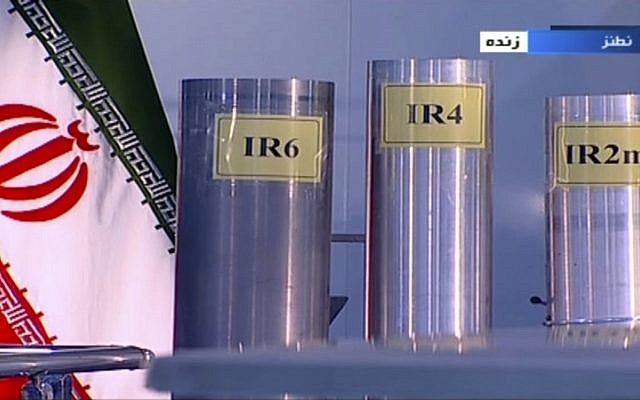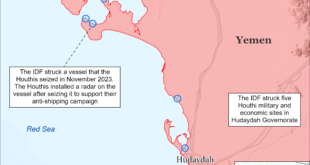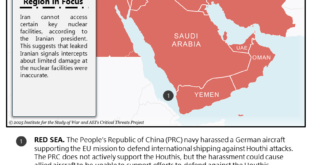Israeli and US intelligence officials reportedly confirm Mossad involvement in apparent cyberattack on uranium enrichment facility, which Tehran calls an act of ‘nuclear terrorism’
The major power cut at Iran’s Natanz nuclear facility, which Tehran described as an act of “nuclear terrorism,” caused significant damage to the centrifuges and set back Iran’s uranium enrichment ability by at least 9 months, Israeli and US media quoted unnamed intelligence sources as saying Sunday.
Senior Israeli officials hinted at, but did not confirm, Israeli involvement in the apparent cyberattack, although the New York Times cited American and Israeli intelligence officials confirming there had been an Israeli role.
An unnamed intelligence official told Israel’s state-owned Kan news that the damage at the site was “extensive” and that various “different types of centrifuges” installed at the top-secret underground center were harmed, setting back Iran’s ability to enrich uranium. Iran had publicly inaugurated cascades of advanced IR-5 and IR-6 centrifuges at the facility on Saturday.
The Kan source said Iran’s abilities had been seriously set back and that the timing of the apparent strike was not coincidental.
“The assessment is that the fault in the Natanz power grid – result of an Israeli cyber operation,” a Kan reporter also tweeted, without any of the usual hedging.
The assessment is that the fault in the Natanz power grid – result of an Israeli cyber operation https://t.co/927kzilLFB
— Amichai Stein (@AmichaiStein1) April 11, 2021Israel’s Channel 13, also citing unnamed intelligence officials, offered a similar assessment, saying that the cyberattack caused “severe damage at the heart of Iran’s enrichment program.”
Meanwhile, the New York Times, citing two intelligence officials briefed on the damage, said that “it had been caused by a large explosion that completely destroyed the independent — and heavily protected — internal power system that supplies the underground centrifuges that enrich uranium.”
The report said that it would take at least nine months to restore Natanz’s production.
In the early hours of Sunday morning, the underground Natanz facility suffered an electrical disruption in what was widely speculated to be an Israeli cyberattack. Iran said the attack did not cause any casualties and did not cause radioactive pollution. Israel has officially refrained from commenting on the matter, and Iran has not specifically accused the Jewish state of being responsible for the incident.
On Sunday evening, unnamed intelligence sources were cited by a number of Hebrew news outlets as saying that the Mossad was involved in the attack.
Israel made no official comment on the incident, but officials, from Prime Minister Benjamin Netanyahu on down, hinted at Israeli responsibility.
The Israeli comments, along with Hebrew media reports attributing the cyberattack to the Mossad, marked a significant change. Israel is normally completely silent on the secret exploits of its security services, and Israel’s military censor routinely prevents publication of such details, forcing local media to cite foreign media reports. But that did not happen this time.
On Sunday, Israel’s government announced that the high-level security cabinet is scheduled to meet next week for the first time since early February, reportedly to discuss the Iran issue. The meeting was said to have been called at the request of Defense Minister Benny Gantz and Attorney General Avichai Mandelblit, in light of the recent exchanges between Israel and Iran.
Netanyahu appeared to refer to the recent events in Iran at a ceremony honoring the country’s security forces on Sunday night, saying the fight against the Islamic Republic was a massive undertaking.
“The fight against Iran and its proxies and the Iranian armament is a giant mission. The situation that exists today doesn’t say anything about the situation that will exist tomorrow,” Netanyahu said.
Sunday’s incident came as US Defense Secretary Lloyd Austin landed in Israel for talks with Netanyahu and Gantz. The US, Israel’s main security partner, is seeking to reenter the 2015 atomic accord aimed at limiting Tehran’s program so that it cannot pursue a nuclear weapon — a move staunchly opposed by Israel, particularly Netanyahu.
Meeting with Austin on Sunday, Gantz said Israel viewed America as an ally against all threats, including Iran.
“The Tehran of today poses a strategic threat to international security, to the entire Middle East and to the State of Israel,” Gantz said. “And we will work closely with our American allies to ensure that any new agreement with Iran will secure the vital interests of the world, of the United States, prevent a dangerous arms race in our region, and protect the State of Israel.”
In addition to an ongoing, largely covert fight on the nuclear front, Tehran and Jerusalem are engaged in a maritime shadow war, with both sides blaming the other for explosions on vessels.
In recent months, at least two Israeli-owned cargo ships have been damaged in alleged Iranian attacks, one in the Gulf of Oman and the other as it was sailing to India.
IDF Chief of Staff Aviv Kohavi appeared to reference the recent tensions between Israel and Iran in a speech on Sunday.
The Israeli military’s “operations in the Middle East are not hidden from the eyes of the enemy,” Kohavi said. “They are watching us, seeing [our] abilities and weighing their steps with caution.”
The timing of the attack came the day after Iran celebrated its National Nuclear Technology Day; the day after Iranian scientists began operating more powerful centrifuges; and amid ongoing talks in Vienna aimed at revitalizing the flagging 2015 nuclear accord between Iran and world powers, which Israel fiercely opposes.
The disruption at Natanz appears to have been designed to counter Iran’s efforts to raise pressure on the United States by amassing greater quantities of uranium and enriching it to higher levels as the two sides negotiate a return to the 2015 nuclear deal.
The spokesman for Iran’s atomic program, Ali Akbar Salehi, confirmed that the electrical disruption at Natanz was a deliberate act of sabotage, calling it “nuclear terrorism.”
In comments carried by Iranian state news, Salehi refrained from identifying a perpetrator, but said the attack was carried out by those who oppose Iran’s ongoing negotiations with the West to remove the sanctions against Tehran through the nuclear deal.
“To thwart the goals of this terrorist movement, the Islamic Republic of Iran will continue to seriously improve nuclear technology on the one hand and to lift oppressive sanctions on the other hand,” Salehi said, according to state TV.
He added: “While condemning this desperate move, the Islamic Republic of Iran emphasizes the need for a confrontation by the international bodies and the (International Atomic Energy Agency) against this nuclear terrorism.”
The apparent strike comes amid surging tensions between Israel and Iran.
Last Tuesday, an Iranian cargo ship said to serve as a floating base for Iran’s paramilitary Revolutionary Guard forces off the coast of Yemen was struck by an explosion, likely from a limpet mine. Iran has blamed Israel for the blast. An American official told the New York times that Israel was behind the attack.
A private Israeli intelligence firm released a satellite photograph of the ship from Sunday, showing that the vessel has not moved since last week’s attack and remained anchored in the Red Sea, directly between Yemen and Eritrea.
The #Iran|ian #Saviz. Today (11 April 2021). Same place at the #RedSea. pic.twitter.com/0nTvCRc4HA
— ImageSat Intl. (@ImageSatIntl) April 11, 2021The Natanz nuclear facility, which maintains aboveground workshops and subterranean uranium enrichment halls, is considered a major facet of Iran’s atomic program. The alleged Israeli attack against it came hours after scientists at the site turned on a chain of 164 advanced IR-6 centrifuges that threatened to shorten the amount of time it would take for Iran to amass the highly enriched uranium needed for a nuclear bomb.
On Saturday, officials also began testing the IR-9 centrifuge, which they say will enrich uranium 50 times faster than Iran’s first-generation centrifuges, the IR-1. The nuclear deal limited Iran to using only IR-1s for enrichment.
Natanz was largely built underground to withstand enemy airstrikes. It became a flashpoint for Western fears about Iran’s nuclear program in 2002, when satellite photos showed Iran building its underground centrifuges facility at the site, some 200 kilometers (125 miles) south of the capital, Tehran.
Last summer, an explosion rocked the Natanz facility, in what was also said to have been an Israeli attack aimed at disrupting uranium enrichment and research at the site.
In 2010, the United States and Israel allegedly halted Iran’s nuclear program with the Stuxnet virus, which caused Iranian centrifuges to tear themselves apart, reportedly destroying a fifth of the country’s machines.
Iran has also blamed Israel for the killing last year of scientist Mohsen Fakhrizadeh, who began the country’s military nuclear program decades earlier.
Since then-US president Donald Trump’s withdrawal from the Iran nuclear deal in 2018, Tehran has abandoned all the limits of its uranium stockpile. It now enriches up to 20 percent purity, a technical step away from weapons-grade levels of 90%. Iran maintains that its atomic program is for peaceful purposes — despite its leaders regularly threatening to destroy Israel and the Mossad stealing and publicizing Iranian documents showing plans to affix a nuclear device onto a missile — but fears about Tehran having the ability to make a bomb saw world powers reach the deal with the Islamic Republic in 2015.
The deal lifted economic sanctions on Iran in exchange for it limiting its program and allowing IAEA inspectors to keep a close watch on its work, though not at military sites and some other locations — a key sticking point for critics of the deal.
US President Joe Biden hopes to return to the 2015 agreement, which his predecessor Trump abandoned in favor of a “maximum pressure” campaign in hopes of bringing Tehran to its knees. However, Biden has maintained that he will remove sanctions on Iran only after it returns to compliance with the nuclear deal. Iran, meanwhile, is demanding full sanctions relief before it returns to the negotiating table.
 Eurasia Press & News
Eurasia Press & News



